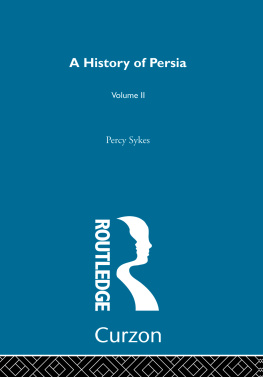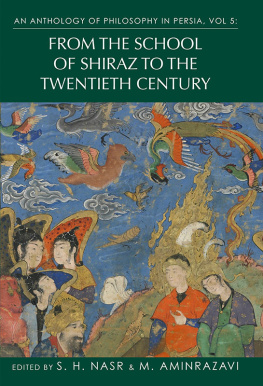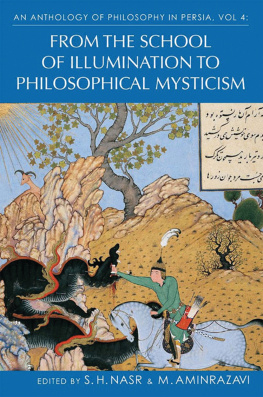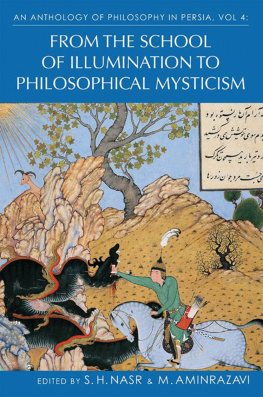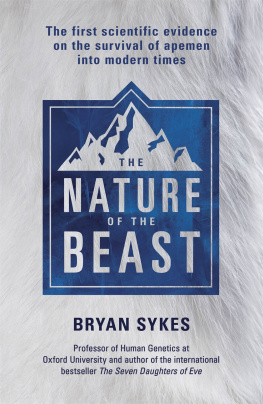A HISTORY OF PERSIA
A HISTORY OF PERSIA
Percy Sykes
VOLUME TWO
First published 1915 by Macmillan & Co. Ltd.
This edition reprints the 1969 third edition published by
Routledge
This edition published 2004
by RoutledgeCurzon
2 Park Square, Milton Park, Abingdon, Oxon, OX14 4RN
Simultaneously published in the USA and Canada
by Routledge
270 Madison Ave, New York NY 10016
RoutledgeCurzon is an imprint of'the Taylor & Francis Group
Transferred to Digital Printing 2006
Copyright 1915 by Sir Percy Sykes
Typeset in Times by Keystroke, Jacaranda Lodge, Wolverhampton
All rights reserved. No part of this book may be reprinted or reproduced or utilised in any form or by any electronic, mechanical, or other means, now known or hereafter invented, including photocopying and recording, or in any information storage or retrieval system, without permission in writing from the publishers.
British Library Cataloguing in Publication Data
A catalogue record for this book is available from the British Library
Library of Congress Cataloging in Publication Data
A catalog record for this book has been requested.
ISBN 0415326788 (Set)
ISBN 041532680X (Vol. II)
Publisher's Note
The Publisher has gone to great lengths to ensure the quality of this reprint but points out that some imperfections in the original book may be apparent
Printed and bound by CPI Antony Rowe, Eastbourne
(Through the courtesy of Doctor Ahmad Khan.)
History is a mirror of the past
And a lesson for the present.
A Persian Proverb.
.
(From an original Persian painting.)
(From Sir John Malcolms History of Persia.)
A
HISTORY OF PERSIA
BY
BRIGADIER-GENERAL SIR PERCY SYKES
K.C.I.E., C.B., C.M.G.
GOLD MEDALLIST OF THE ROYAL GEOGRAPHICAL SOCIETY JOINT-AUTHOR OF THROUGH DESERTS AND OASES OF CENTRAL ASIA AND THE GLORY OF THE SHIA WORLD
ACHAEMENIAN GOLD PATERA.
(From British Museum.)
WITH MAPS AND ILLUSTRATIONS
IN TWO VOLUMESVOL. II
THIRD EDITION
LONDON
ROUTLEDGE AND KEGAN PAUL
1969
PART OF A PERSIAN HUNTING SCENE.
(From a Polychrome Terra-cotta Vase in the Hermitage Museum.)
CONTENTS
The Expedition of Kawam-ul-Mulk
Solat-u-Dola
ABAGA.
ILLUSTRATIONS
Shah Abbas the Great
MAP
VOL. II
Persia
MOHAMED SHAVBANI.
FROM A TILE OF THE FOURTEENTH CENTURY.
VOLUME II
For this volume, there is not as much new material to be considered as in Volume I., in its earlier portion, while later events are dealt with in a Final Essay. I have studied various books, and would specially refer to the valuable work of Messrs. Amedroz and Margoliouth.1 But in view of the brief space that is allotted to the period, I was unable to do more than check what I had already written, although I added considerably to my knowledge of the subject.
(To be read with ., pp. 1636.)
The question of Selim the Grim inducing the puppet Caliph to hand over his authority to him has been dealt with by Sir Thomas Arnold.2 He pointed out that there was no contemporary mention of the transfer, although there were two Turkish and one Persian historian in the camp who would, without any doubt, have mentioned such an important event. Consequently we are led to believe that the formal transfer of spiritual authority was invented in later times. We also know that the Sultans of Turkey had assumed the title of Caliph many generations before Selim.
The campaigns of Sulayman and his negotiations with Persia are mentioned by Busbecq,3 who served as ambassador of the Emperor Ferdinand at Constantinople from 1554 to 1562. The ambassador was a keen observer and in his journey across Asia Minor to the camp of Sulayman near the Persian frontier gives a valuable description of the country and of its inhabitants. He was present in 1555 when the Persian Ambassador arrived, and states: Peace was granted on the spot, in order that greater attention might be paid to us.
1 The Eclipse of the Abbaside Caliphate, by H. F. Amedroz and D. S. Margoliouth, 7 vols. (Basil Blackwell, 1921). I would also mention The Arab Conquests in Central Asia, by H. A. R. Gibb, R.A.S. (1921); and The Persian Gulf, by Lt.-Colonel Sir Arnold Wilson (Clarendon Press, 1928).
2 The Caliphate, p. 138.
3 The Turkish Letters of Ogier-Ghiselin de Busbecq, translated by E. S. Forster (Clarendon Press, 1927).
MAHUN AND THE IMAM RIZA.
THE GOLDEN AGE OF ISLAM
It was a dynasty abounding in good qualities, richly endowed with generous attributes, wherein the wares of Science found a ready sale, the merchandise of Culture was in great demand, the observances of Religion were respected, charitable bequests flowed freely and the frontiers were bravely kept.AL-FAKHRI on the Abbasid Dynasty.
.
Adown the Tigris I was borne,
By Bagdats shrines of fretted gold,
High-walled gardens green and old;
True Mussulman was I and sworn,
For it was in the golden prime
Of good Haroun Alraschid.
These lines from Tennyson, based on the immortal Arabian Nights, indicate both the magnificence of the golden age of Islam and its close association with Haroun, the Solomon of the Abbasid dynasty. Bold and of active habit, the great Caliph took part in the almost annual campaigns waged against the Byzantine Empire, and during his reign Moslem fleets fought successfully in the Mediterranean. Everywhere Islam was in the ascendant.
It is of much interest to note that Charlemagne despatched an embassy to Haroun, composed of two Christians and a Jew, the latter presumably the interpreter, who sought for easier access to the Holy Sepulchre and wished to foster trade with the Caliphate, The return gifts from Haroun included an elephant, the first to be seen in Western Europe for many centuries,1 and upon the instructions of the Caliph the Patriarch of Jerusalem sent the keys of the Holy Sepulchre to Charlemagne. Haroun, at the request of the Frank ambassadors, not only protected Western pilgrims who visited the Holy Land, but even built a hospice for their entertainment, a convincing proof of his broad outlook. From Chinese sources we learn that an embassy was also sent by Haroun to the Emperor of China. But these embassies were mere incidents unrecorded by the Arab chroniclers, who love to dilate on the splendour of the Caliphs Court and the number of philosophers, doctors of law, poets, and other learned men who assembled there and inaugurated a period which reached its zenith under Mamun. It was the lavish generosity of Haroun, who rewarded a poet for a sonnet by a gift of 5000 pieces of gold, ten Greek slave-girls, a horse, and a robe of honour, that drew men of letters to his Court. The main credit for this movement is due to him, though, to some extent, he was following in the footsteps of his father.










